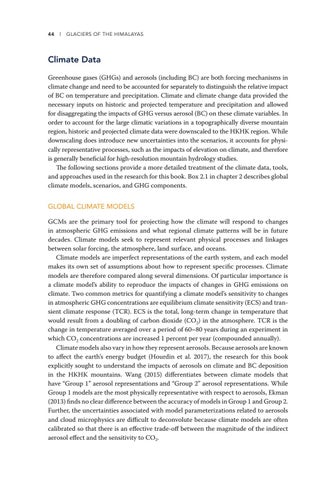44 l Glaciers of the Himalayas
Climate Data Greenhouse gases (GHGs) and aerosols (including BC) are both forcing mechanisms in climate change and need to be accounted for separately to distinguish the relative impact of BC on temperature and precipitation. Climate and climate change data provided the necessary inputs on historic and projected temperature and precipitation and allowed for disaggregating the impacts of GHG versus aerosol (BC) on these climate variables. In order to account for the large climatic variations in a topographically diverse mountain region, historic and projected climate data were downscaled to the HKHK region. While downscaling does introduce new uncertainties into the scenarios, it accounts for physically representative processes, such as the impacts of elevation on climate, and therefore is generally beneficial for high-resolution mountain hydrology studies. The following sections provide a more detailed treatment of the climate data, tools, and approaches used in the research for this book. Box 2.1 in chapter 2 describes global climate models, scenarios, and GHG components. GLOBAL CLIMATE MODELS GCMs are the primary tool for projecting how the climate will respond to changes in atmospheric GHG emissions and what regional climate patterns will be in future decades. Climate models seek to represent relevant physical processes and linkages between solar forcing, the atmosphere, land surface, and oceans. Climate models are imperfect representations of the earth system, and each model makes its own set of assumptions about how to represent specific processes. Climate models are therefore compared along several dimensions. Of particular importance is a climate model’s ability to reproduce the impacts of changes in GHG emissions on climate. Two common metrics for quantifying a climate model’s sensitivity to changes in atmospheric GHG concentrations are equilibrium climate sensitivity (ECS) and transient climate response (TCR). ECS is the total, long-term change in temperature that would result from a doubling of carbon dioxide (CO2) in the atmosphere. TCR is the change in temperature averaged over a period of 60–80 years during an experiment in which CO2 concentrations are increased 1 percent per year (compounded annually). Climate models also vary in how they represent aerosols. Because aerosols are known to affect the earth’s energy budget (Hourdin et al. 2017), the research for this book explicitly sought to understand the impacts of aerosols on climate and BC deposition in the HKHK mountains. Wang (2015) differentiates between climate models that have “Group 1” aerosol representations and “Group 2” aerosol representations. While Group 1 models are the most physically representative with respect to aerosols, Ekman (2013) finds no clear difference between the accuracy of models in Group 1 and Group 2. Further, the uncertainties associated with model parameterizations related to aerosols and cloud microphysics are difficult to deconvolute because climate models are often calibrated so that there is an effective trade-off between the magnitude of the indirect aerosol effect and the sensitivity to CO2.




